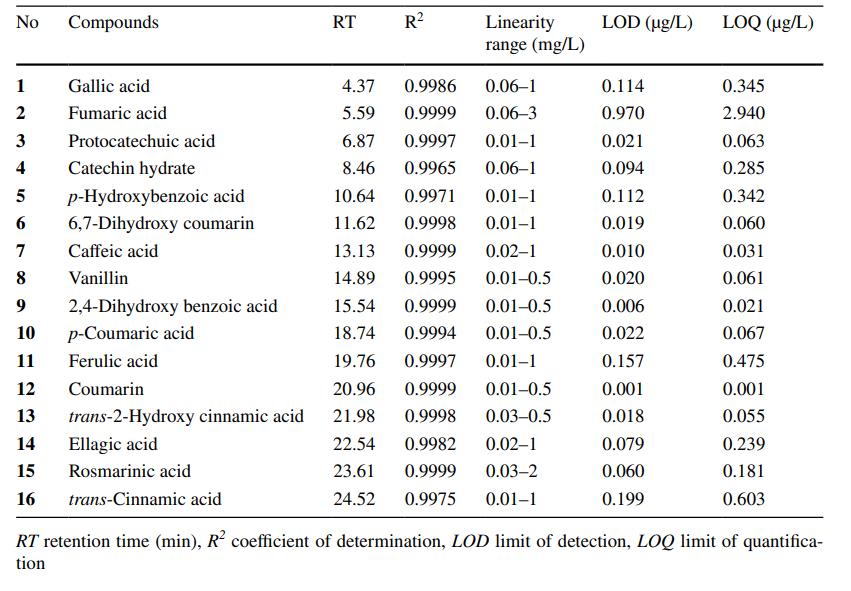Title: Identifcation and quantifcation of phenolic acid compounds of twenty‑six mushrooms by HPLC–DAD
Journal: Journal of Food Measurement and Characterization
Published: 2020
Background
Mushrooms are globally recognized for their nutritional value and medicinal properties. They are rich in proteins, vitamins, and minerals while being low in calories and fats. In addition to their nutritional benefits, mushrooms contain bioactive compounds like phenolic acids, which have demonstrated anti-inflammatory, antioxidant, anti-tumor, and antimicrobial effects. The study of phenolic acids in mushrooms is important due to their potential role in disease prevention. This research aimed to identify and quantify phenolic acid compounds in 26 different mushroom species using high-performance liquid chromatography (HPLC) coupled with a photodiode array detector (DAD). The analysis revealed 16 different phenolic acid compounds across the mushroom species, contributing to the standardization of phenolic acid profiles in mushrooms.
Materials & Methods
Chemicals and Reagents:
- HPLC grade solvents were sourced from E. Merck (Germany).
- Phenolic compounds such as gallic acid, fumaric acid, protocatechuic acid, catechin hydrate, p-hydroxy benzoic acid, and others were obtained from Sigma-Aldrich (Germany).
Instrument:
High-performance liquid chromatography (HPLC) analysis was performed using a Shimadzu 20 AT series HPLC with a photodiode array detector (DAD), manufactured by Shimadzu Corporation (Japan).
Mushroom Samples:
26 mushroom species were collected from Anatolia, and voucher specimens were deposited at the Muğla Sıtkı Koçman University fungarium.
Extraction:
Mushroom samples (3 g) were extracted with acetone:water (80:20 v/v, 30 mL) at −18 °C for 24 hours. After ultrasonic bath and centrifugation, the extracts were filtered and evaporated to remove acetone. The final extract was dissolved in water:methanol (80:20) for HPLC analysis.
HPLC–DAD Conditions:
Separation was achieved using an Intertsil ODS-3 reverse-phase C18 column (5 µm, 250 mm × 4.6 mm) at 40 °C, with a flow rate of 1.5 mL/min. The mobile phases were: (A) 0.5% acetic acid in water and (B) 0.5% acetic acid in methanol, with a gradient elution. The detection was carried out at 280 nm.
Analytical parameters for HPLC–DAD analysis

Method Validation:
The chromatographic method was validated for linearity, limit of detection (LOD), limit of quantification (LOQ), and repeatability using calibration curves from known concentrations of standard phenolic compounds.
Statistical Analysis:
Data were recorded as mean ± S.E.M. and significant differences were determined using Student's t-test (p < 0.05).
Results
Phenolic Acid Composition
A total of 16 phenolic and organic acid compounds were identified across the 26 mushroom species: gallic acid, fumaric acid, protocatechuic acid, catechin hydrate, p-hydroxy benzoic acid, 6,7-dihydroxy coumarin, caffeic acid, vanillin, 2,4-dihydroxy benzoic acid, p-coumaric acid, ferulic acid, coumarin, trans-2-hydroxy cinnamic acid, ellagic acid, rosmarinic acid, and trans-cinnamic acid.
Highest Phenolic Content
- The highest total phenolic content was found in Suillus granulatus (71.79 µg/g) and Lepista nuda (68.38 µg/g).
- Gallic acid was the most abundant in Russula aurora (2.96 µg/g), while 6,7-dihydroxy coumarin was predominant in Armillaria tabescens (2.07 µg/g) and Leucoagaricus leucothites (9.02 µg/g).
Specific Compounds Analysis
- Gallic Acid: The highest gallic acid content was found in R. aurora (2.96 µg/g), while the lowest was in R. delica (0.07 µg/g).
- Fumaric Acid: L. nuda contained the highest amount of fumaric acid (53.70 µg/g), whereas L. leucothites had the lowest (4.42 µg/g).
- Catechin: The highest catechin levels were found in A. vaginata (20.50 µg/g), and the lowest in L. personata (1.33 µg/g).
- Caffeic Acid: Found only in A. vaginata, C. atramentarius, L. sulphureus, and M. elata, with values ranging from 0.08 µg/g to 0.25 µg/g.
- Vanillin: The content of vanillin ranged from 0.08 µg/g in C. dryophila to 0.23 µg/g in C. atramentarius.
- Ferulic Acid: Ranged from 0.01 µg/g in M. elata to 0.35 µg/g in R. delica.
Bioactivity Insights
- Gallic Acid showed a range of bioactivities including anticancer, anti-HIV, anti-inflammatory, and antimicrobial effects.
- Fumaric Acid was noted for its antioxidant and antimicrobial properties.
- Catechin has been linked with antioxidant, anti-allergy, and anticancer effects, along with blood glucose-lowering properties.
- Ferulic Acid was associated with anti-atherosclerotic and antioxidant activities.
The study indicated that mushrooms are a valuable source of phenolic compounds, many of which are known for their health-promoting properties.
 HPLC–DAD chromatogram of standard phenolic compounds
HPLC–DAD chromatogram of standard phenolic compounds
Reference
- Çayan, Fatih, et al. "Identification and quantification of phenolic acid compounds of twenty-six mushrooms by HPLC–DAD." Journal of Food Measurement and Characterization 14 (2020): 1690-1698.




